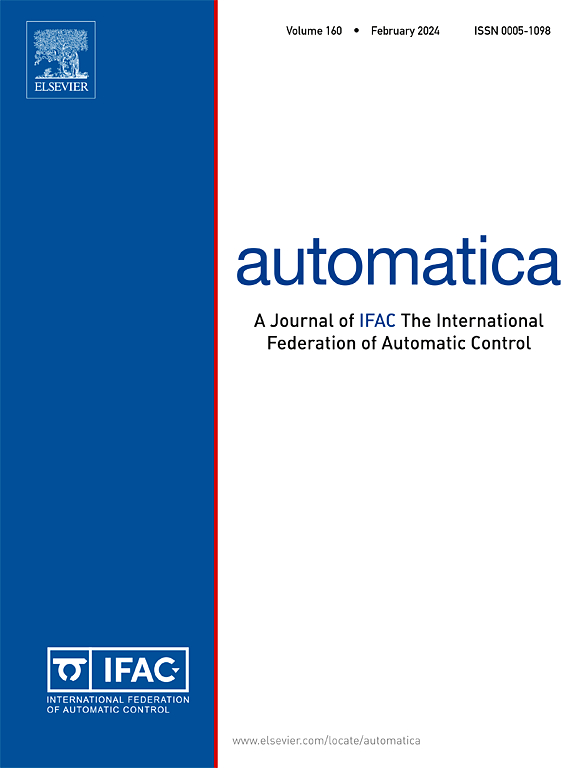高速公路交通自适应控制的神经算子
IF 5.9
2区 计算机科学
Q1 AUTOMATION & CONTROL SYSTEMS
引用次数: 0
摘要
人类驾驶行为的不确定性导致高速公路上走走停停的交通拥堵。高速公路交通动力学由松弛时间未知的aw - rasle - zhang (ARZ)交通偏微分方程(PDE)模型控制。针对自适应交通控制问题,针对具有不确定域内系数和边界参数空间变化的耦合2 × 2双曲系统,提出了一种基于神经算子的自适应边界控制设计方法。在传统的偏微分方程自适应控制中,在线求解反步核的计算量很大,因为它需要在每个时间步更新系数的估计。为了应对这一挑战,我们使用算子学习(即DeepONet)来学习从系统参数到核函数的映射。DeepONet是一类为近似算子而设计的深度神经网络,在最近的研究中显示出近似PDE反演设计的强大潜力。与以往的工作不同,我们将该框架扩展到一类一阶耦合2 × 2双曲核方程的PDE核近似。我们的方法表明,DeepONet在生成核函数方面比传统的PDE求解器快了近两个数量级,同时保持了10−3的损失。此外,在自适应控制器中采用deeponet逼近核时,我们通过李雅普诺夫分析严格地建立了系统的稳定性。并与强化学习(RL)方法进行了比较。我们的方法保证了稳定性,并且不依赖于初始值,这对于快速变化的交通场景至关重要。这是该算子学习框架首次应用于ARZ交通模型的自适应控制,显著增强了该设计框架缓解交通拥堵的实时性。本文章由计算机程序翻译,如有差异,请以英文原文为准。
Neural operators for adaptive control of freeway traffic
The uncertainty in human driving behaviors leads to stop-and-go traffic congestion on freeway. The freeway traffic dynamics are governed by the Aw–Rascle–Zhang (ARZ) traffic Partial Differential Equation (PDE) models with unknown relaxation time. Motivated by the adaptive traffic control problem, this paper presents a neural operator (NO) based adaptive boundary control design for the coupled 2 × 2 hyperbolic systems with uncertain spatially varying in-domain coefficients and boundary parameter. In traditional adaptive control for PDEs, solving backstepping kernel online can be computationally intensive, as it updates the estimation of coefficients at each time step. To address this challenge, we use operator learning, i.e. DeepONet, to learn the mapping from system parameters to the kernels functions. DeepONet, a class of deep neural networks designed for approximating operators, has shown strong potential for approximating PDE backstepping designs in recent studies. Unlike previous works that focus on approximating single kernel equation associated with the scalar PDE system, we extend this framework to approximate PDE kernels for a class of the first-order coupled 2 × 2 hyperbolic kernel equations. Our approach demonstrates that DeepONet is nearly two orders of magnitude faster than traditional PDE solvers for generating kernel functions, while maintaining a loss on the order of . In addition, we rigorously establish the system’s stability via Lyapunov analysis when employing DeepONet-approximated kernels in the adaptive controller. The proposed adaptive control is compared with reinforcement learning (RL) methods. Our approach guarantees stability and does not rely on initial values, which is essential for rapidly changing traffic scenarios. This is the first time this operator learning framework has been applied to the adaptive control of the ARZ traffic model, significantly enhancing the real-time applicability of this design framework for mitigating traffic congestion.
求助全文
通过发布文献求助,成功后即可免费获取论文全文。
去求助
来源期刊

Automatica
工程技术-工程:电子与电气
CiteScore
10.70
自引率
7.80%
发文量
617
审稿时长
5 months
期刊介绍:
Automatica is a leading archival publication in the field of systems and control. The field encompasses today a broad set of areas and topics, and is thriving not only within itself but also in terms of its impact on other fields, such as communications, computers, biology, energy and economics. Since its inception in 1963, Automatica has kept abreast with the evolution of the field over the years, and has emerged as a leading publication driving the trends in the field.
After being founded in 1963, Automatica became a journal of the International Federation of Automatic Control (IFAC) in 1969. It features a characteristic blend of theoretical and applied papers of archival, lasting value, reporting cutting edge research results by authors across the globe. It features articles in distinct categories, including regular, brief and survey papers, technical communiqués, correspondence items, as well as reviews on published books of interest to the readership. It occasionally publishes special issues on emerging new topics or established mature topics of interest to a broad audience.
Automatica solicits original high-quality contributions in all the categories listed above, and in all areas of systems and control interpreted in a broad sense and evolving constantly. They may be submitted directly to a subject editor or to the Editor-in-Chief if not sure about the subject area. Editorial procedures in place assure careful, fair, and prompt handling of all submitted articles. Accepted papers appear in the journal in the shortest time feasible given production time constraints.
 求助内容:
求助内容: 应助结果提醒方式:
应助结果提醒方式:


